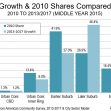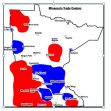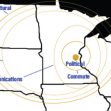
Community has the Power
There are so many things that we ‘know’ that just aren’t so. Can the community rise to its rightful position and establish a long term vision, with an implementing structure, and take responsibility for its own future?
Work as We Know It
Jeremy Rifkin’s book, The End of Work discusses the three sectors in the American economy. He asserts that the community sector is the fulcrum that must keep the public and private sectors in check. A quick scan of the country will probably confirm the depiction of figure 1.
There is not a lot of balance or accountability in America today, yet the need may have never been greater. Looking at the organizational structure of the private and public sectors (figures 2 and 3) and comparing them to the community sector, figure 3, you might ask: What’s the point of trying?
A Community Driven Future
Clearly the public and private sectors have the resources, structure, staff and ‘attitude’ that gives them both the sense that they are in charge of their own domain; the reality however is that both are totally dependent upon the complacency and apathy of the community. That can change.
 Figure 2- Private Sector
Figure 2- Private Sector
_______________________________________________________________________________________________
 Figure 3- Public Sector
Figure 3- Public Sector
In contrast to the other sectors, figure 4 illustrates the community sector which is bottom up, i.e., residents vote for the candidates for various offices but these offices are often controlled by rules and regulations developed by the public sector. If the community sector role is to balance the other two sectors it is currently far too weak to even marginally influence the other sector’s activities. However, when you realize that the community sector pays all the taxes that support the public sector and buys the products that support the private sector maybe it is time to reassess who truly has the power.
 Figure 4- Community Sector
Figure 4- Community Sector
The question is: Will the community overcome the status quo and assert its fundamental obligation to apply the forces necessary to balance the excesses of the other two sectors?
The community which, presumably feels powerless in the face of the bureaucracy, must learn to focus its real power. It is ironic that the community sector appears to be the weakest of the three sectors when in fact it has the potential to be the most powerful. New tools and new strategies are needed to re-establish the community’s role of balancing the other two sectors in making the Smart Region successful. The community is the fulcrum; the community must act like it has the power- because it does.
Coming up in our next post:
The Community Dialogue Process and Recommendations
Things you can do …
- Read my book: “Slaying the Status Quo”
- Share what you think are the problems we face and how they can be addressed.
- Respond to this post with a comment below.
- Contact me John Sanger by email or phone 651-486-8408
 SmartRegions.US is a community-driven strategy for restoring neighborhood viability by integrating rural-urban economies.
SmartRegions.US is a community-driven strategy for restoring neighborhood viability by integrating rural-urban economies.



